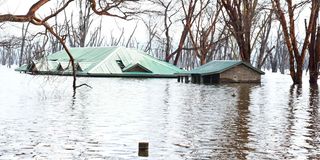Rising water levels wreak havoc on Lake Nakuru National Park

Houses at Lake Nakuru National Park main gate are submerged by rising Lake Nakuru water on October 1, 2020.
The rising waters of Lake Nakuru have caused damage estimated at Sh500 million to the world-renowned Lake Nakuru National Park, according to a review report.
The statement prepared by a multi-agency technical team shows that the steadily rising water levels have submerged about 26.6 square kilometres of the park and affected 677 families in Barut, Parkview, and Mwariki areas.
It has also affected the riparian ecosystem, displacing wildlife, and destroying infrastructure such as roads, and buildings.
It said the Kenya Wildlife Service (KWS) requires more funds to rehabilitate its facilities damaged by the waters.
"In Lake Nakuru National Park, the upsurge of water levels has caused damage amounting to millions and KWS will require Sh105 million to rehabilitate the infrastructure. It is estimated that the KWS will also require Sh25 million to replace the submerged infrastructure," said the report.
It added that KWS has incurred expenses amounting to Sh600,000 in demolishing structures that had been submerged as well as relocating offices and staff to temporary facilities.
Human-wildlife conflicts have also been reported to be on the rise. As a result baboons, monkeys, and snakes that escape from the park have caused havoc in the neighbourhood.
The report, which traced the rising levels to 2010, when the lake first overflowed, indicated that the water body has increased its flood area from 3,268.71 ha in January 2010 to 5,400.27 ha in October 2020, an increase of 2,131.56 ha.
Consider compensating
The report warned that Lake Nakuru might double its water level by 2030 to cover 82 square kilometres from 43 square kilometres in 2010.
The task force recommended that the government consider compensating and buying the land and property of the affected households in the flood-prone areas of Mwariki, Barut, and Lakeview.
The team is led by the county executive committee member for Water, Environment and Natural Resources, Festus Ng'eno.
“The government should consider purchasing the land and relocating the people who live around the lake,” said Mr Ng’eno.
Jackson Raini, an environmental expert and member of the task force, cited seismic and other underground movements as the cause of the rising water levels,
"The tectonics create a near field (a localised area affected by the earth's activities) and far field (an earth area that is far away) compressional and tensional stress fields,” said Mr Raini.
Other reasons advanced by experts are seasonal rainfall and evaporation.
According to Mr Raini, climate change has for over a decade led to high rainfall in the region, causing ground oversaturation.
Kiogora Muriithi, the chief officer for Water, Environment, Energy and Natural Resources, said the government should in future map the affected riparian land for conservation purposes.
In 2020, hundreds of households around Lake Nakuru were displaced. Vegetation was submerged as the water swallowed up several establishments in the neighborhood, including homesteads and farms in Barut and Lakeview areas.
Lake Nakuru, traditionally viewed as a flamingo refuge, saw thousands of the birds flee to other areas.
Decreasing spaces
Hundreds of animals in Lake Nakuru National Park were displaced.
The lake’s water invaded the park, flooding hundreds of acres that provided food and shelter to wildlife, squeezing the animals into rapidly decreasing spaces.
Environment experts said the lake’s water levels have been steadily rising since around 2011.
Lake Nakuru Park is a sanctuary for a variety of wildlife, including Rothschild giraffes, buffaloes, and black rhinos.





